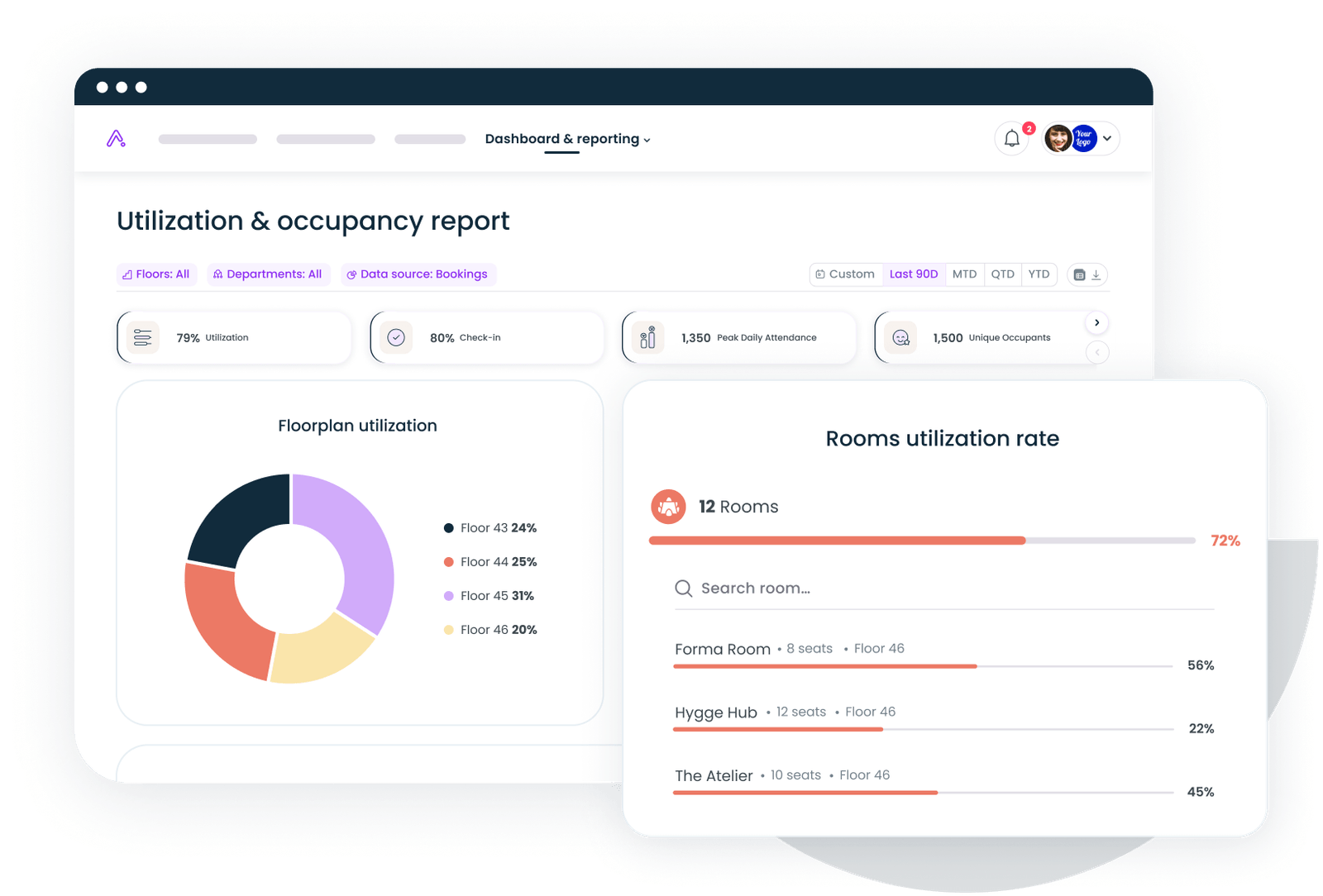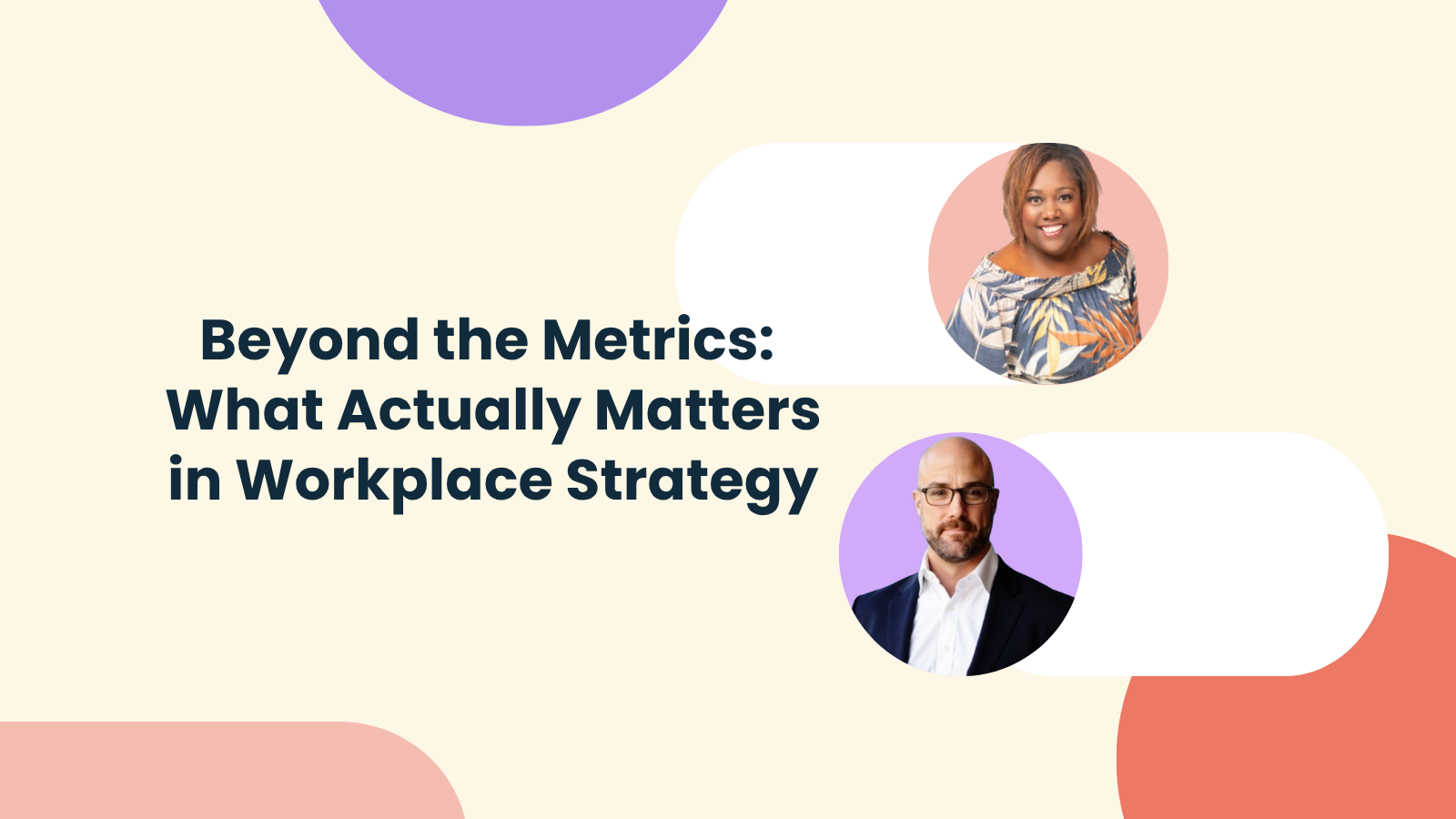Webinar Recap: Key Takeaways from a webinar held on Oct 30, 2025 with Eric Waldron and Tamar Draper Mahru.
Most workplace leaders are tracking everything—badge swipes, utilization rates, cost per square foot. But when you ask what changed because of those numbers, there isn't always a clear answer.
That was the opening question in our recent webinar with Eric Waldron, Head of Global Real Estate and Workplaces at 6Sense, and Tamar Draper Mahru, a workplace consultant who's led strategy at companies like Airbnb and Twilio.
Here's what stood out.
The Problem with Lagging Metrics
Tamar opened with something most workplace leaders don't want to admit: we're creating metrics for the sake of having metrics.
"Metrics are absolutely useful," she said. "But we often get into a trap of making metrics that help us prove our worth without understanding why, how, and what they're going to be used for."
The biggest culprit? Anything that starts with "cost per." Cost per square foot. Experience cost per employee. These are budgetary decisions, not experiential ones. They tell you what you spent, not whether it mattered.
Eric echoed this: "Cost per square foot or attendance rate on their own don't mean much. Good executives care about the story and the business case behind the metric."
The takeaway: Metrics should clarify outcomes you're trying to achieve, not just prove you did something. If you can't explain why a metric matters or what you'll do with it, stop measuring it.
What Happens When You Stop Looking Backward
Both speakers agreed: if workplace leaders stopped relying on historical data alone, they'd experiment more.
Tamar put it plainly: "Lagging data helps us understand what we did in the past, but if we stopped looking backward at numerical data, I think we would experiment more. And experimentation allows us to be the most creative in solving today's problems and tomorrow's problems."
Eric added that workplace leaders should focus on being responsive instead of predictive. "We already have all the signals—badge data, room bookings, Slack chatter. People have already told us how they want to work. The art is reading those signals and adjusting the environment to match in real time."
Real estate might operate on 3-5 year lease cycles, but workplace strategy has to pivot monthly or even weekly. That agility is what separates a space that's just open from one that's alive.
The takeaway: Build hypotheses, run experiments, and iterate. Treat workplace strategy like product development—test, learn, adjust.
What Workplace Leaders Should Stop Doing
This question sparked one of the most interesting exchanges of the session.
Tamar's answer: Stop looking for a narrow set of skills that aren't rooted in what real estate and workplace actually require.
"What we need is curiosity for the built environment," she said. "We've gotten away from that. Workplace has evolved from facilities to real estate to bleeding into HR. But understanding how buildings work—how HVAC systems function, how design impacts behavior—that curiosity still matters."
She also pushed back on the expectation that workplace leaders own employee retention. "It's not our job to keep long-tenured employees at a company. That's not really our responsibility. We can create beautiful environments and run great events, but no one has ever left because there weren't enough snacks."
Eric agreed but added nuance: "We can create the connective tissue that holds people together. But we need the budget, the autonomy, and the permission not to get it right every time."
The takeaway: Workplace leaders should stop trying to do everything. Focus on what you can control—the built environment, culture moments, operational excellence—and partner with HR on the rest.
Making Offices Worth the Commute
Eric's perspective on this was refreshingly honest: "You're not going to compete with home. So we decided to complement it instead. The office should offer what home can't—community, energy, belonging, a little magic."
At 6Sense, that's meant everything from curated hub days with team-driven themes to surprise hospitality moments. But the biggest unlock? Friday Giving—a program where 6Sense redirects office perk budgets to charitable donations suggested by employees.
"We've donated about half a million dollars so far to more than 100 organizations," Eric said. "People really light up when they see their values reflected in company action. That's an experience you can't quantify, but it drives engagement and pride."
Tamar reinforced the importance of intentionality. "If you're coming to the office and sitting on Zoom calls all day, what's the purpose? Creating moments for collaboration and connection is what makes the commute worth it."
The takeaway: Stop trying to beat the home office. Create what home can't offer—connection, energy, and belonging.


The Role of AI in Workplace Operations
Both speakers use AI daily, and their advice was consistent: start small, stay curious, and use it to buy back time.
Eric uses AI to summarize lease terms, draft communications, analyze attendance patterns, and design event materials. "It doesn't replace my judgment—it amplifies it. If you can automate 10% of your workload, you can use that time toward culture, connection, and care, which is where our value really lies."
Tamar agreed: "I use it every day. Why not? It's a tool. One of the things I love most is being able to use natural language—literally just thinking out of my head. It amplifies the speed at which non-essential parts of what we do can get done."
She also emphasized what AI won't replace: "It's not going to replace our creativity or our decision-making. It will never replace the trades or design. But it can help us get the boring aspects done faster so we can do things that are more valuable."
The takeaway: AI is a brainstorming partner and efficiency tool, not a replacement. Learn to use it now or risk falling behind.
Skills Workplace Leaders Need (But Don't Talk About)
Eric's answer: Anticipatory thinking. The ability to look around a corner and have what people need before they know they need it.
"My prior career was as a concierge at the Four Seasons," he said. "I needed to have what people needed before they knew they needed it. That ability—to read the room, understand needs, and have everything prepared—changes everything."
He also emphasized working in the gray. "We don't often get a form that tells us what's allowed and what's not. That gray area enables us to have the flexibility to deliver spaces that are current with what our teams want."
Tamar's answer: Know your business. "We are the business behind the business. In order to be that, we have to know the business we're supporting. That means connecting with salespeople to understand what they're selling. Connecting with product leaders to understand what they're building next. Really understanding how the business makes its money."
The takeaway: The best workplace leaders anticipate needs, work in ambiguity, and deeply understand the business they support.
The Question No One Wants to Answer
The final Q&A question asked: What measurements best correlate workplace engagement with business outcomes?
Eric laughed. "There isn't one. It's not a thing."
Tamar agreed: "It is not an equal sign at all. It's this plus this, plus this, plus this. Maybe you get to a business outcome, but it's murky waters to make that straight line connection."
Eric explained: "The things that come out of workplace and real estate are employee satisfaction, how much they enjoy working there, whether they feel welcome. Happy employees don't leave a company. And the longer people stay, the more knowledge they get, the better they are at their jobs. So the longevity we find from treating employees well stems from all of that mishmash of metrics."
Tamar added: "If there are organizations where leaders are asking for that quick equal sign, it's imperative for workplace leaders to know their business so well that they can explain why that doesn't work. But then lead them through how the metrics we create lead to something they can understand helps the business."
The takeaway: There's no single metric that proves workplace engagement drives business outcomes. But happy employees stay longer, perform better, and contribute more. Your job is to tell that story with the data you have.
What to Do Next
If this conversation resonated, here are three things you can do:
- Audit your metrics. Ask yourself: Does this metric help me make a decision, or does it just prove I did something? If it's the latter, stop measuring it.
- Run an experiment. Pick one thing about your workplace strategy and test it. Give it 30 days. Measure what happens. Iterate.
- Learn to use AI. Start small—summarize an email thread, draft an event plan, analyze badge data. Buy back 10% of your time and reinvest it in culture and connection.
See how Gable helps workplace leaders make data-driven decisions about space, people, and engagement.
Get a demo





.svg)





.svg)
















.svg)















